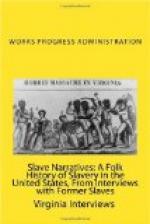“When the war broke out my mistress’ home became a sewing center and deifferent women in the neighborhood would come there every day to make clothes for the soldiers. On each bed was placed the vests, coats, shirts, pants, and caps. One group did all the cutting, one the stitching, and one the fitting. Many women cried while they served [TR: sewed?] heart-broken because their husbands and sons had to go to the war. One day the Yanks came to our plantation and took all of the best horses. In one of their wagons were bales of money which they had taken. Money then was blue in color; of course, there was silver and gold. After taking the horses they drank as much whisky as they could hold and then filled their canteens. The rest of the whisky they filled with spit. The master didn’t interfere for fear of the long guns which they carried.”
After the war some of the slaves left the plantation to seek their fortune; others remained, renting land from the Willis family or working with them on a share crop basis.
As a conclusion Mrs. Callaway remarked: “My folks were good and I know [HW: they’re] in heaven.” Mrs. Callaway is deeply religious and all during the interview would constantly drift to the subject of religion. She is well cared for by her nine children, six girls and three boys.
PLANTATION LIFE AS VIEWED BY EX-SLAVE
Susan Castle, Age 78 1257 W. Hancock Ave. Athens, Georgia
Written by:
Sadie B. Hornsby
Athens
Edited by:
Sarah H. Hall
Athens
and
John N. Booth
District Supervisor
Federal Writers’ Project
Augusta, Georgia
On a beautiful morning in April, the interviewer found Susan sitting in the door of her cabin. When asked if she would like to talk about the old plantation days, she replied; “Yes Ma’am, I don’t mind tellin’ what I know, but for dat I done forgot I sho’ ain’t gwine make nothin’ up. For one thing, I ain’t never lived on no plantation. I was a house servant in town.” She added: “Do you mind me axin’ you one favor?” Consent was given and she continued: “Dat is, please don’t call me Aunt Susan; it makes me feel lak I was a hundred years old.
“I was borned in Clarke County, March 7, 1860; I believes dat’s what dey say. Mudder was named Fannie and Pappy’s name was Willis. Us chillun called ’im Pappy lak he was de onliest one in de world. He fust belonged to Marse Maxwell of Savannah, Georgia. I was so little I disremembers how Pappy come by de name of Castle. In all de seben of us chillun, I didn’t have but one brudder, and his name was Johnny. My five sisters was Mary, Louvenia, Rosa, Fannie, and Sarah. All I ’members ’bout us as chilluns was dat us played lak chilluns will do.
“In de quarters us had old timey beds and cheers, but I’ll tell you whar I slept most times. Hit was on a cot right at de foot of Mist’ess’ bed. I stayed at de big house most of de time at night, and ’fore bedtime I sot close by Mist’ess on a foot stool she had special for me.




